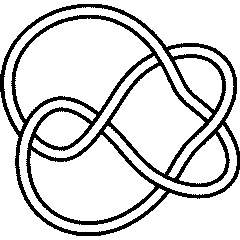The Kauffman Polynomial: Difference between revisions
No edit summary |
No edit summary |
||
| (12 intermediate revisions by 7 users not shown) | |||
| Line 7: | Line 7: | ||
(here <math>s</math> is a strand and <math>s_\pm</math> is the same strand with a <math>\pm</math> kink added) and |
(here <math>s</math> is a strand and <math>s_\pm</math> is the same strand with a <math>\pm</math> kink added) and |
||
<center><math>L(\backoverslash)+L(\slashoverback) = z\left(L(\ |
<center><math>L(\backoverslash)+L(\slashoverback) = z\left(L(\smoothing)+L(\hsmoothing)\right)</math></center> |
||
and by the initial condition <math>L(U)=1</math> where <math>U</math> is the unknot [[Image:BigCirc symbol.gif|20px]]. |
and by the initial condition <math>L(U)=1</math> where <math>U</math> is the unknot [[Image:BigCirc symbol.gif|20px]]. |
||
| Line 18: | Line 18: | ||
<!--Robot Land, no human edits to "END"--> |
<!--Robot Land, no human edits to "END"--> |
||
{{HelpAndAbout| |
{{HelpAndAbout| |
||
n = |
n = 2 | |
||
n1 = |
n1 = 3 | |
||
in = <nowiki>Kauffman</nowiki> | |
in = <nowiki>Kauffman</nowiki> | |
||
out= <nowiki>Kauffman[K][a, z] computes the Kauffman polynomial of a knot or link K, in the variables a and z.</nowiki> | |
out= <nowiki>Kauffman[K][a, z] computes the Kauffman polynomial of a knot or link K, in the variables a and z.</nowiki> | |
||
about= <nowiki>The Kauffman program was written by Scott Morrison.</nowiki>}} |
about= <nowiki>The Kauffman polynomial program was written by Scott Morrison.</nowiki>}} |
||
<!--END--> |
<!--END--> |
||
| Line 29: | Line 29: | ||
<!--Robot Land, no human edits to "END"--> |
<!--Robot Land, no human edits to "END"--> |
||
{{InOut| |
{{InOut| |
||
n = |
n = 4 | |
||
in = <nowiki>Kauffman[Knot[5, 2]][a, z]</nowiki> | |
in = <nowiki>Kauffman[Knot[5, 2]][a, z]</nowiki> | |
||
out= <nowiki> 2 4 6 5 7 2 2 4 2 6 2 3 3 |
out= <nowiki> 2 4 6 5 7 2 2 4 2 6 2 3 3 |
||
| Line 37: | Line 37: | ||
2 a z + a z + a z + a z</nowiki>}} |
2 a z + a z + a z + a z</nowiki>}} |
||
<!--END--> |
<!--END--> |
||
{{Knot Image Pair|5_2|gif|T(8,3)|jpg}} |
|||
It is well known that the Jones polynomial is related to the Kauffman polynomial via |
It is well known that the Jones polynomial is related to the Kauffman polynomial via |
||
<center><math>J(L)(q) = (-1)^ |
<center><math>J(L)(q) = (-1)^{c+1}L(K)(-q^{-3/4},\,q^{1/4}+q^{-1/4})</math>,</center> |
||
where <math>K</math> is some knot or link and where <math>c</math> is the number of components of <math>K</math>. Let us verify this fact for the torus knot [[T(8,3)]]: |
where <math>K</math> is some knot or link and where <math>c</math> is the number of components of <math>K</math>. Let us verify this fact for the torus knot [[T(8,3)]]: |
||
| Line 47: | Line 49: | ||
<!--Robot Land, no human edits to "END"--> |
<!--Robot Land, no human edits to "END"--> |
||
{{In| |
{{In| |
||
n = |
n = 5 | |
||
in = <nowiki>K = TorusKnot[8, 3];</nowiki>}} |
in = <nowiki>K = TorusKnot[8, 3];</nowiki>}} |
||
<!--END--> |
<!--END--> |
||
| Line 57: | Line 59: | ||
<!--Robot Land, no human edits to "END"--> |
<!--Robot Land, no human edits to "END"--> |
||
{{InOut| |
{{InOut| |
||
n = |
n = 6 | |
||
in = <nowiki>Simplify[{ |
in = <nowiki>Simplify[{ |
||
(-1)^(Length[Skeleton[K]]-1)Kauffman[K][-q^(-3/4), q^(1/4)+q^(-1/4)], |
(-1)^(Length[Skeleton[K]]-1)Kauffman[K][-q^(-3/4), q^(1/4)+q^(-1/4)], |
||
Latest revision as of 17:23, 21 February 2013
The Kauffman polynomial (see [Kauffman]) of a knot or link is where is the writhe of (see How is the Jones Polynomial Computed?) and where is the regular isotopy invariant defined by the skein relations
(here is a strand and is the same strand with a kink added) and
and by the initial condition where is the unknot ![]() .
.
KnotTheory` knows about the Kauffman polynomial:
(For In[1] see Setup)
|
| ||||||||
Thus, for example, here's the Kauffman polynomial of the knot 5_2:
In[4]:=
|
Kauffman[Knot[5, 2]][a, z]
|
Out[4]=
|
2 4 6 5 7 2 2 4 2 6 2 3 3
-a + a + a - 2 a z - 2 a z + a z - a z - 2 a z + a z +
5 3 7 3 4 4 6 4
2 a z + a z + a z + a z
|
 5_2 |
 T(8,3) |
It is well known that the Jones polynomial is related to the Kauffman polynomial via
where is some knot or link and where is the number of components of . Let us verify this fact for the torus knot T(8,3):
In[5]:=
|
K = TorusKnot[8, 3];
|
In[6]:=
|
Simplify[{
(-1)^(Length[Skeleton[K]]-1)Kauffman[K][-q^(-3/4), q^(1/4)+q^(-1/4)],
Jones[K][q]
}]
|
Out[6]=
|
7 9 16 7 9 16
{q + q - q , q + q - q }
|
[Kauffman] ^ L. H. Kauffman, An invariant of regular isotopy, Trans. Amer. Math. Soc. 312 (1990) 417-471.












